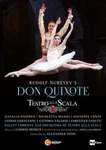|
Back
05/16/2016
Ludwig Minkus (arr. John Lanchbery): Don Quixote
Giuseppe Conte (Don Quixote), Natalia Osipova (Kitri/Dulcinea), Leonid Sarafanov (Basilio), Gianluca Schiavoni (Sancho Panza), Matthew Endicott (Lorenzo), Riccardo Massimi (Gamache), Lusymay Di Stefano/Denise Gazzo (Friends of Kitri), Vittoria Valerio (A street dancer/Fandango soloist), Christian Fagetti (Espada/Fandango soloist), Nicoletta Manni (The Queen of the Dryads), Serena Sarnataro (Cupid), Antonino Sutera (A gypsy), Deborah Gismondi/Emanuela Montanari (Two gypsies), Luigi Saruggia/Caroline Westcombe (The King and Queen of the gypsies), Virna Toppi (A bridesmaid), Ballet Company of Teatro alla Scalla, Makhar Vaziev (Ballet Director), Students of the Ballet Academy of Teatro alla Scalla, Frédéric Olivieri (Director), Orchestra of Teatro alla Scala, Alexander Titov (Conductor), Rudolf Nureyev (Choreography), Marius Petipa (Original Choreography), Raffaele del Savio (Set Designer), Anna Anni (Costume Designer), Marco Filibeck (Lighting Designer), Patrizia Carmine (Video Director)
A co-prodction of RAI and Teatro alla Scala
High definition live recording: Teatro alla Scala, Milan, Italy (September 25, 2014) – 120’
C Major Entertainment #735708 (or Blu-ray #735804) – Sound PCM Stereo or DTS 5.1 – Format NTSC 16:9 – Region 0 – Booklet in English, German and French (Distributed by Naxos of America)

   
Those savoring Marius Petipa will find this Nureyev transcription amusing, whimsical and comically pleasing. Alongside John Lanchbery’s revisionist-thinking, the protocols of formality and polite respect are mildly swept aside to make way for a more frivolous and sassy approach.
The Lanchbery orchestration melts Minkus’ snappy, delineated edging down to a rotund softness and legato (particularly Act II’s “Dream Scene”), especially with an over-gifting of brass and sections of bombastic, sliding notes. If one has seen his reconstitution of Hérold’s La Fille mal gardée in 2015 (Read here), one will definitely recognize the musical pastiche gadgetry incorporated into his own Don Quixote. The Nureyev/Lanchbery consort has been broadly adopted as the norme aestétique. Aided by the Russian’s 1961 defection, Nureyev’s brilliant reconstitution (he didn’t take kindly to Petipa’s vision) dares to penetrate with an elixir of commedia dell’arte characterization that’s likely to be loved and embraced by a majority. But Don Quixote somehow lacks an aura of crispness that prevails in the Minkus/Petipa partnership.
Alexander Titov’s orchestra is “momentum on steroids”, particularly found within Act I. The resultant is invigorating, dizzying and energetic. Crowd scenes are active and fluid, yet they never fight with the soloists. Here, this comic ballet is over-embellished as if pulling wildly from a bag of slapstick and ebullient humor.
But this vaudeville-esque angle ironically liquidates cardboard cutouts and replaces them with more humanistic ones. The compact treasures of long legs and lithe lines build Natalia Osipova’s Kitri/Dulcinea and Leonid Sarafanov’s Basilio as an ardent couple with a raw passion reaching beyond anything Petipa would have crafted.
What we see is a sort of verismo persuasion. This notion is accentuated through the corps de ballet scenes, particularly in the Gypsy Camp with Antonino Sutera as the dynamic and exceptionally acrobatic ring leader: it’s as if we’re watching Bizet’s Carmen. This down-to-earth valuation is particularly well served in the dressings by Anna Anni; however, sharp lines get hampered by the bohemian cloth. Conversely, Act II’s second section mollifies those unwavering non-converts with expectant white tutus and shiny tiaras.
It is in Act II’s “Dream Scene” that we, as the audience, develop stronger pathos for Don Quixote: Giuseppe Conte’s delivery is delicate and charming particularly when aided by Mr. Lanchbery’s interpretation featuring beautiful, lush harp runs. The chivalric knight buries himself into mayhem as he fights the windmills. These additions broaden Don Quixote and give him greater depth though he still gets mired into that aimless, wandering stupor. Gianluca Schiavoni’s Sancho Panza is entertaining enough and seldom does he escape from the sight of his master.
One of highlights of this DVD is Nicoletta Manni. Her Queen of the Dryads is well prepared as evidenced by signature footwork and grounding while the arabesques unveil with stately intention, and they are emphatic and lasting. Cupid (Serena Sarnataro) is sufficiently spritely along with strong performances by Lusymay Di Stefano and Denise Gazzo as Kitri’s two friends.
On a more ridiculous tilt, leprechaun-like Gamache (Riccardo Massimi) adds to the farce with his Charlie Chaplin-esque attempts to court Kitri. The end result drenches with buffoonish élan and Keystone Cop chemistry.
Video directing by Patrizia Carmine has good intentions, but the camera gets too inventive: the use of x, y and z axes pleases, but sudden camera shots from above (z), then panning quickly back to the x and y planes interrupt the loving arches and reaches.
Pantomiming is greatly enhanced (though overweighed) to entertain the viewer. Act III’s “Grand pas de deux” is anti-climactic since Nureyev doesn’t utilize grand leaps that would, otherwise, capitalize on Minkus’ grand passage. In contrast, the closing solo Kitri/Basilio variations and combinations ignite the Nureyev imagery splendidly.
Rudolf Nureyev’s Don Quixote will resonate to a great crowd, but the comedy occasionally gets out of hand which impertinently side-swipes the respectabilities of Marius Petipa and Ludwig Minkus.
Christie Grimstad
|